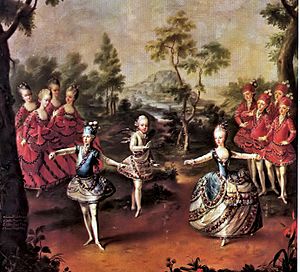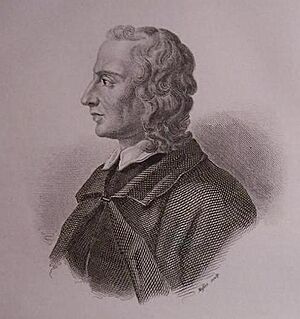Pietro Metastasio facts for kids
Quick facts for kids
Pietro Metastasio
|
|
|---|---|
 |
|
| Born |
Antonio Domenico Bonaventura Trapassi
January 3, 1698 |
| Died | April 12, 1782 (aged 84) |
| Nationality | Italian |
| Occupation | Poet and librettist |
Pietro Metastasio (born January 3, 1698 – died April 12, 1782) was a famous poet from Italy. His real name was Antonio Domenico Bonaventura Trapassi. He was born in Rome and later lived in Vienna. For a long time, he was the official poet for the Holy Roman Emperor. He is best known for writing librettos. These are the stories and words for operas. Many different composers used his librettos. More than 800 operas have words written by Metastasio!
Contents
Pietro Metastasio's Early Life
Pietro Metastasio was born in Rome in 1698. His real name was Antonio Domenico Bonaventura Trapassi. His father was a soldier and later owned a small shop. His family was not rich.
When he was a little boy, Metastasio loved to make up poems. He would say them out loud in the streets of Rome. One day, a rich lawyer named Giovanni Vincenzo Gravina heard him. Gravina was very impressed.
Gravina decided to help the young boy. He adopted Metastasio and paid for him to go to school. He also changed the boy's name to Pietro Metastasio. When Gravina died, Metastasio was 20 years old. Gravina left all his money to Metastasio. Metastasio wrote a long poem to remember his adopted father. It was called La strada della gloria, which means The Road of Glory.
Becoming a Famous Writer
When he was a young man, Metastasio worked as a lawyer in Naples. Naples was a very musical city back then. It had beautiful opera houses. In Naples, Metastasio took music lessons from a composer named Nicola Porpora. He enjoyed singing and playing the harpsichord. He even wrote some of his own music.
Metastasio also earned money by writing poems for special events. These included weddings and birthdays for famous people. In 1724, he wrote his first opera libretto. It was called Didone abbandonata. This story was about Queen Dido and her love for Aeneas, a Trojan prince.
This first opera was a huge success! Metastasio stopped working as a lawyer. He decided to write librettos and poems full-time. Soon, he became famous all over Italy for his opera stories.
Moving to Vienna
Charles VI, Holy Roman Emperor heard about Metastasio's talent. He asked Metastasio to come to Vienna to be his official poet. In March 1730, Metastasio moved to Vienna. He lived there for the rest of his life.
He wrote many more opera librettos for the emperor's theatre. After the emperor died, Metastasio continued to work for the emperor's daughter, Maria Theresa of Austria.
Metastasio died in 1782 when he was 84 years old. He was buried in St. Michael's Church in Vienna. He left all his money to the children of his good friends, the Martinez family. Today, there are monuments to Metastasio in Rome and Vienna. There are also theatres named after him in Italy.
What Are Metastasio's Librettos?

Metastasio wrote 26 librettos for a type of opera called opera seria. Opera seria means "serious opera." These operas usually told stories about ancient heroes or gods. Many different composers used Metastasio's librettos. More than 800 operas have words written by him!
Here are some of his famous opera seria librettos:
- Didone Abbandonata (1724): This title means Dido Abandoned. It tells the sad story of Dido, the first queen of Carthage. She had an unhappy love for Aeneas. This was Metastasio's first libretto. The first opera using it was by Domenico Sarro. Over the next 100 years, more than 40 other composers used this same story!
- Ezio (1728): This story is about Flavius Aetius. He was a Roman general in the 400s. Ezio is the Italian name for Aetius. Many composers used this libretto. These include George Frideric Handel, Christoph Willibald Gluck, and Nicola Porpora.
- Siroe (1733): This tells the story of Siroes, a king of Persia in the 600s. George Frideric Handel and Antonio Vivaldi were among the many composers who used this libretto.
- La Clemenza di Tito (1734): The title means The Mercy of Titus. It is about Titus, a Roman emperor in the 1st century. This libretto was used many times. The most famous opera using it is La Clemenza di Tito by Wolfgang Amadeus Mozart.
- Achille in Sciro (1736): This title means Achilles in Skyros. It tells the story of the Ancient Greek hero, Achilles. When Achilles was young, he lived on the Greek island of Skyros. The first opera using this libretto was by Antonio Caldara. It was performed in Vienna to celebrate the wedding of Maria Theresa of Austria.
Metastasio also wrote librettos for other kinds of musical stories. These were used for cantatas (pieces for singers and instruments), oratorios (like operas but without costumes or acting), ballets, and short operas called azione. An azione usually told a happy or funny story. They were performed at royal courts for celebrations.
One azione by Metastasio was called Il Trionfo d'Amore. This means Cupid Wins. It was performed in 1765 to celebrate the wedding of Maria Theresa of Austria's son, Joseph II. Maria Theresa's younger children even sang and danced in this performance!
Images for kids
See also
 In Spanish: Pietro Metastasio para niños
In Spanish: Pietro Metastasio para niños




